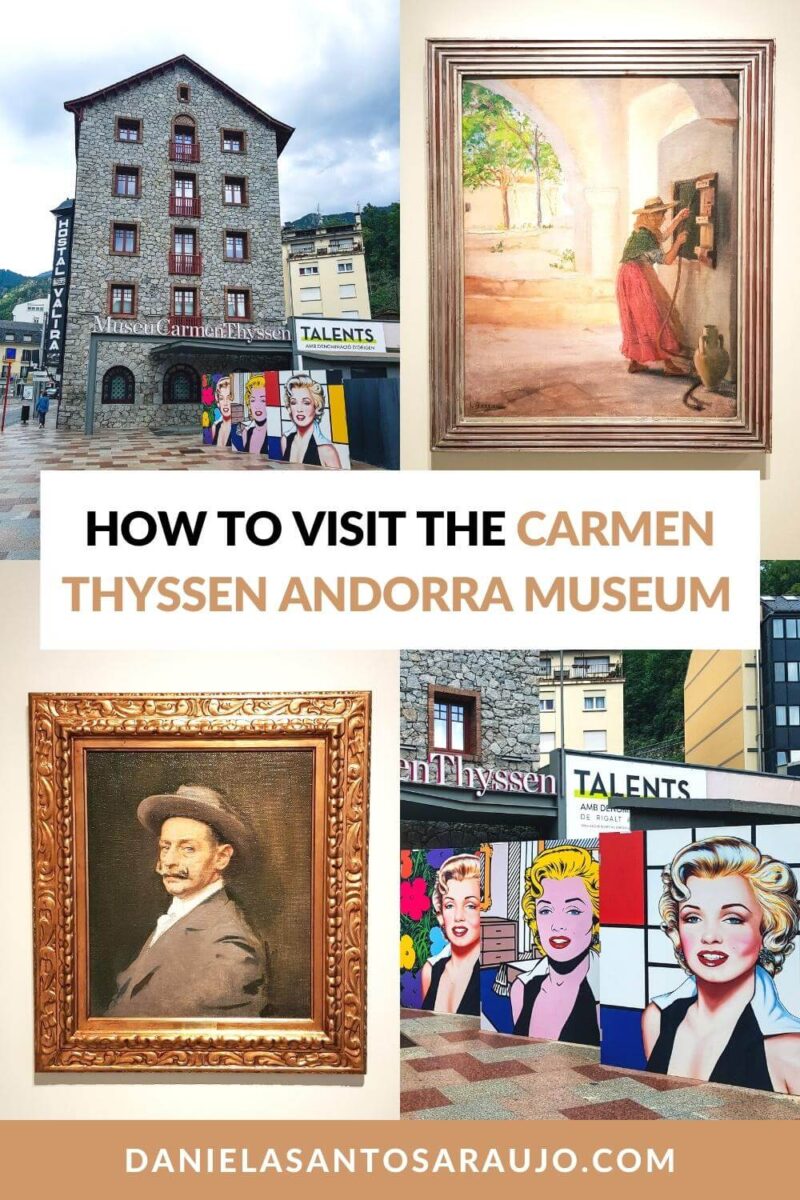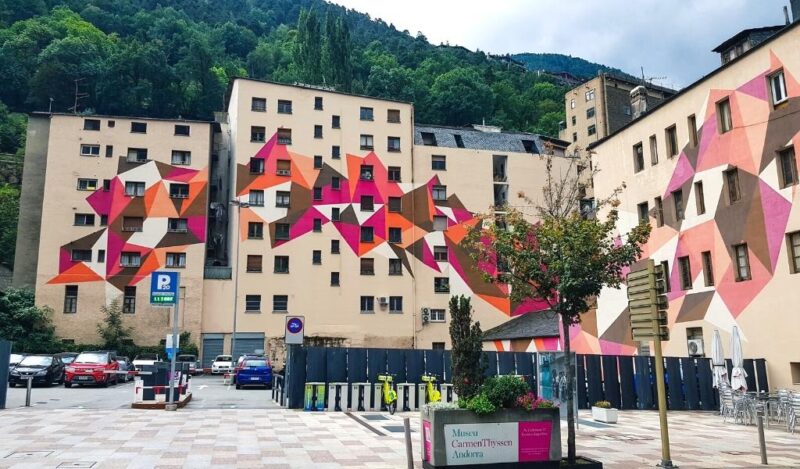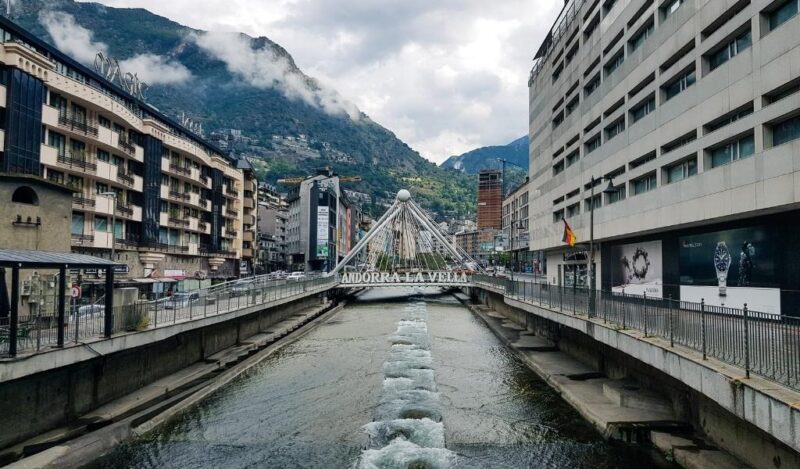The Carmen Thyssen Andorra Museum belongs to one of the most important private collections in the world: the Carmen Thyssen-Bornemisza Collection. Located in Escaldes-Engordany, one of the seven parishes that make up the Principality of Andorra, it features mostly paintings from the 19th and 20th centuries.
Inaugurated in 2017, the Carmen Thyssen Museum has quickly become one of the most visited museums in Andorra, largely due to its temporary exhibitions, which are renewed every year. This way, tourists have an opportunity to discover new works of art on every visit!
So, do you want to know more about the Carmen Thyssen Andorra Museum: Best Tips For Visiting In 2024? Keep reading!
This post may contain affiliate links, meaning I earn a small commission if you make a purchase, at no additional cost to you. Please read my disclosure & privacy policy for more information.
No time to read now? Pin it for later!


Brief History of the Carmen Thyssen Andorra Museum
The Museu Carmen Thyssen Andorra opened on March 16th, 2017, on the ground floor of the old Hostal Valira. Interestingly, it’s the first international museum created from that private collection, after the Museo Nacional Thyssen-Bornemisza (in Madrid) and the Museo Carmen Thyssen Málaga (in Andalusia).

Carmen Thyssen (also known as Carmen “Tita” Cervera) is the widow of entrepreneur and art collector Hans Heinrich Thyssen-Bornemisza. Known as an art dealer and collector on the international scene, the Spanish socialite also stands out for her philanthropic work.
What to See at the Carmen Thyssen Andorra Museum
For several decades, the Baron and Baroness Thyssen-Bornemisza gathered a large number of works of art, which was once considered the second-largest private collection in the world after the Royal British Collection!
Their paintings can be organized into three major geographic groups – Spain, Europe, and the United States – and include particularly relevant works of art from three artistic movements: Impressionism, Post-Impressionism, and Expressionism.
“Retrat del dramartug Joaquín Dicenta”, by Ramon Casas i Carbó
Ramon Casas i Carbó (1866-1932) is undoubtedly the most famous artist in this exhibition at the Carmen Thyssen Andorra Museum.
Born in Barcelona, Ramon Casas dedicated a large part of his life to portraits, painting the most varied figures of European high society.

However, he also excelled as a graphic designer, creating posters for magazines and establishments such as Els Quatre Gats (a café in Barcelona, which was the meeting point for artists during Catalan Modernism).
In this 1905 oil painting, the protagonist is the Spanish playwright, writer, and poet Joaquín Dicenta, a close friend of the painter.
“Pati i figura”, by Santiago Rusiñol i Prats
One of Ramon Casas i Carbó’s great friends and co-workers was Santiago Rusiñol i Prats (1861-1931), who was also a painter, poet, and playwright.
Santiago Rusiñol was one of the most prolific artists of his generation, having created over a thousand paintings and published numerous works, both in Catalan and Spanish.

Born in Barcelona, he was one of the first representatives of Catalan Modernism, painting bucolic landscapes of this Spanish region and scenes related to everyday life – such as this painting “Pati i figura”.
“Prats de Santa Coloma, Andorra”, by Joaquim Mir i Trinxet
The post-impressionist painting by Joaquim Mir i Trinxet that is on display at the Carmen Thyssen Andorra Museum clearly distinguishes itself from others due to the use of color. In reality, this Spanish artist born in Barcelona was very well known precisely for the vivid colors of his landscape paintings.

After studying at the Escola Llotja – the oldest art and design school in Spain, where many Catalan artists started their formation – Mir i Trinxet joined two cultural groups responsible for the development of Catalan Modernism: the Colla del Safrà and Els Quatre Gats.
“A l’era, batent”, by Laureà Barrau Buñol
Laureà Barrau Buñol (1863-1957) is one of the few artists with more than one painting on display at the Carmen Thyssen Andorra Museum – the others are Lluís Rigalt i Farriols, Joan Roig y Soler, Joaquim Terruella Matilla, and Rafael Durancamps i Folguera.

Also known as Laureano Barrau, the painter was born in Barcelona and was one of the great names of Spanish Impressionism. After having studied with the master Jean-Léon Gérôme in Paris, Laureà Barrau devoted himself to painting countryside landscapes, making farmers the protagonists of his works.
“Platja de Vilanova”, by Joan Roig i Soler
In this temporary exhibition at the Carmen Thyssen Andorra Museum, I noticed an interesting fact: of the 28 paintings that comprise it, only 5 belong to the Col·lecció Carmen Thyssen – the rest are part of the Col·lecció d’art de Crèdit Andorrà! Platja de Vilanova by Joan Roig i Soler is one of those five and the others are:
- “Eivissenca traient aigua del pou”, by Laureà Barrau Buñol
- “Flors al vas”, by Rafael Durancamps i Folguera
- “Corbera de Llobregat”, by Lluís Rigalt i Farriols
- “Platja de Port de Llançà”, by Joaquim Terruella Matilla

Joan Roig i Soler (1852-1909) was born in Barcelona and was a disciple of Modest Urgell i Inglada – another artist represented in this exhibition. A fervent fan of landscape painting, he created paintings from the most varied seaside locations in the region of Catalonia.
Practical Guide to the Carmen Thyssen Andorra Museum
As I mentioned in the introduction, the Carmen Thyssen Andorra Museum is distinguished by the uniqueness of its collection, which is constantly changing. Therefore, it’s important to research which temporary exhibition is in the museum before visiting!
I had the opportunity to observe and admire the painting exhibition “Talents amb Denominació d’Origen – From Rigalt to Puigdengolas.” (in English, “Talented Painters of the Same Origin. From Rigalt to Puigdengolas”), a partnership between the Col·lecció d’art de Crèdit Andorrà and the Col·lecció Carmen Thyssen.
1. Pick the Day Wisely
The Carmen Thyssen Andorra Museum is open every day (except on Mondays), from 10 am to 6 pm, but on Saturdays, it closes at 7 pm and on Sundays at 2 pm. In other words, it’s best not to visit Andorra (or even Escaldes-Engordany, where the museum is located) on a Sunday or Monday!
I visited Andorra on a day trip from Barcelona and knew that since I only had one day, I had to make the most of everything that Andorra la Vella and Escaldes-Engordany had to offer. So, I chose to travel to the principality on a Saturday to make sure I found the monuments open.
2. Look Out for Discounts
The ticket to visit the Carmen Thyssen Andorra Museum costs €9, but admission is free for children under 18 and has a reduced price (5€) for people over 65 and under 26 (or holders of the Youth Card).
Normally, I recommend buying museum tickets in advance (and if you want, you can do it at the museum’s online ticket office), but I don’t think that in this case it’s justified. The vast majority of tourists visit Andorra la Vella for skiing or shopping, so it’s rare to find queues at cultural venues!
3. Don’t Forget to Admire the Exterior of the Museum!
The Hostal Valira (in English, Hotel Valira) is a former hotel and spa establishment that, despite having closed in 2000, remains one of the most important buildings in Les Escaldes – an urban area in the parish of Escaldes-Engordany – due to its history and architecture.
The granite building was designed in 1933 by architect Pere Celestí Gusi i Rossell, a disciple of Josep Puig i Cadafalch – one of the great figures of modernist architecture. Celestí Gusi was also a Benedictine monk and it’s known that the Hostal Valira was promoted by Antoni Maria Marcet i Poal, the Abbot of Montserrat.
Initially, the Hotel Valira was intended to serve as a residence for monks, but it ended up becoming a luxury hotel. With its permanent closure in the 21st century, the various floors of the building were converted into apartments and the ground floor eventually became the Carmen Thyssen Andorra Museum.
Share this blog post on your social media!
More Posts about Andorra
1 Day In Escaldes-Engordany: The Perfect Escaldes-Engordany Itinerary
1 Day In Andorra La Vella: The Perfect Andorra La Vella Itinerary
Casa De La Vall: Best Tips For Visiting In 2024
More Posts about Museum Guides
Jewish Museum Of Prague: Best Tips For Visiting In 2024
Mucha Museum: Best Tips For Visiting In 2024
Gustave Moreau Museum: Best Tips For Visiting In 2024
What Photography Gear Do I Use?
- Camera Body: Fujifilm X-T4 Mirrorless
- Camera Lens: Fujinon XF 18-55 mm F2.8-4 R LM OIS
- Tripod: Manfrotto Compact Action
- Small Tripod: Manfrotto PIXI Mini
- Smartphone Adaptor: Manfrotto PIXI Clamp
- Memory Card: SanDisk 128GB Extreme PRO SDXC






